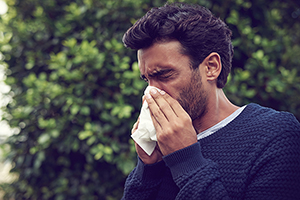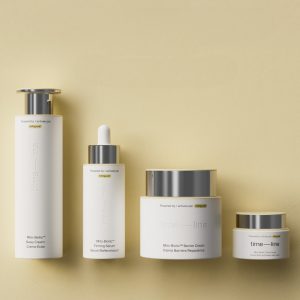
Environmental toxins aren’t the only external cause of fatigue. Even more common are allergies caused by substances such as molds and pollens. Countless Americans suffer from allergies, and along with their sniffly noses and stinging eyes, they experience fogginess, spaciness and fatigue. From pollen wafting on a summer breeze to molds growing on a shady, damp porch, elements of the natural world can wreak havoc in the lives of allergic individuals. And yet there are effective solutions to this extremely common cause of fatigue.
I recently saw a 22-year-old woman who was suffering from extraordinary fatigue, headaches, jitteriness and inability to concentrate. Rita’s doctor thought she might be suffering from hyperthyroidism, but her tests were normal. Her doctor finally referred her to a psychologist, who concluded she was having severe emotional problems related to work anxiety. Rita admitted that she usually felt sick at work but on weekends she felt “great.”
The catch was that she had held her job for three years and only when the company had moved to a new building had she started feeling tired and sick. I instantly suspected she was suffering from “sick building” syndrome. I asked her to take mold plates to her office and expose them. When we had the mold plates analyzed, they came back with a total fungus and mold growth “too numerous to count.” The predominant fungus was an unusual one that usually grows in the soil but can thrive in damp paper, fabric and straw. My patient went to her employer armed with this report, and an inspection of the elaborate ducting and ventilation system was made. Large, stagnant pools of water were found in the drain pans, and they were totally blanketed with a heavy overgrowth of mold. Her company then contacted a firm that came in and cleaned the ducts of the entire building’s cooling system–where mites, mold and mildew can accumulate. Once the building’s air system was cleaned, my patient’s fatigue cleared up.
Mold can be found almost everywhere, and all molds produce spores, airborne “seeds” that cause allergic reactions in many individuals. In fact, a study reported in the British Medical Journal found that damp, moldy housing is significantly linked to health symptoms. Nearly 600 adults and more than 1,100 children were surveyed, their homes were inspected for dampness and mold growth, and air samples were taken of mold spore counts. Dampness was found in 23.3 percent of the households and mold growth in nearly 50 percent. Adults living in moldy houses had many different health symptoms, and children had wheezing, cough, runny nose, fever, and headaches and were likely to have medications prescribed.
Here are just a few common molds:
Hormodendrum: It grows on plants, leather, rubber, cloth, paper and wood. It is one of the most common causes of health problems.
Aspergillus fumigatus: Found in soil, in damp hay, on grain, on sausage and on fruit. The No. 1 cause of respiratory disease in humans.
Phoma: Grows on magazines, books and other paper products.
Penicillium notatum: Grows on fruits, breads and cheese. Mutant strains are used to produce the lifesaving antibiotic penicillin.
Mold growth is stimulated by warmth and high humidity, so it tends to be most prevalent during the hot, humid summer months. Walk into a lovely, lush forest grove, with a damp carpet of leaves under your feet, and you have just entered a veritable mold emporium. Basements, compost piles, cut grass, barns and wooded areas all are high in molds. Taking a hot shower in an old bathroom can cause the mold count to soar temporarily. But I increasingly find cases like that of my patient Rita — where the home or office environment is growing a coat of mold as fertile as a rain forest.
An important point about mold allergy is that it often is related to an overgrowth of candida, a fungus that causes cross-reactivity to many other yeasts, fungi and molds. Once a candida allergy has been triggered in the body, a patient may begin to experience allergies to other common molds without understanding the cause of his cyclical fatigue.
Mold and mildew can be controlled with many different products. Allergy Control Products (800-422-DUST) offers humidity gauges, room air cleaners, dehumidifiers and electrostatic air filters. They offer vinyl box-spring protectors and face masks. To avoid mold in your home, follow these general guidelines:
- Keep humidity as low as 35 percent if possible but never more than 50 percent. Measure humidity with a gauge.
- Use an air conditioner or dehumidifier in the summer and spray the air filter with a mold-killing spray.
- Ventilate your house. Tightly closed houses encourage mold growth.
- Keep refrigerators clean. Empty water pans below self-defrosting refrigerators and clean garbage cans frequently.
- Make sure tiles, shower stall, tub, toilet tank and ceiling are regularly cleaned with mold-killing solutions. Do not carpet your bathroom.
- Use a dehumidifier in the basement and cover the floor with a plastic barrier. (Avoid carpeting over concrete, since that encourages mold growth.)
- Remove carpeting in bedroom and encase mattress in impermeable zippered covers. Avoid foam rubber, which is likely to become moldy.
- Be aware that books, wood paneling, old magazines, newspapers and wallpaper paste support mold growth. Mold grows well in damp, dark closets. A low-watt lightbulb can help prevent mold growth in closets.
- Test tropical fibers in burlap bags, hula skirts and grass place mats. Kapok and jute, two common tropical fibers, are common reservoirs for mold. Kapok is an Indonesian fiber that is stuffed into life jackets, sleeping bags, cushions, and pillows. One test, by Richard Harris, a Beverly Hills allergist, found that 10 patients out of 59 were allergic to kapok and nine were allergic to jute.
- Use a good-quality air cleaner to remove mold spores from the air. Portable units usually are not effective.
- When outdoors, avoid cutting grass and raking leaves. If you must engage in these activities, use a face mask. Try to avoid woods where mold growth on rotted logs is high.
- Use a solution of equal parts of household bleach and water to kill mold. Or buy commercial products such as X-14 in a spray dispenser.
Mold allergy is only one cause of allergic fatigue. Allergies are actually shockingly widespread in today’s society. More than 20 million Americans suffer from hay fever. About 10 million are victims of asthma, and another 11 million suffer from skin disorders such as eczema, hives and rashes. Many allergic individuals don’t realize that their unusual fatigue, irritability, and mood swings may be due to allergic reactions.
Could simple dust be making you sick, achy and tired? Dust allergy is one of the most common unrecognized allergies I see in my practice, and like other allergies, it inevitably causes fatigue.
For centuries doctors have thought that something in household dust could trigger allergies, but it wasn’t until 1964 that a Dutch scientist discovered the microscopic cause of the problem: the dust mite, a little bug related to spiders and ticks that dines on flakes of human skin in carpets, drapes, bedding and upholstery and leaves tiny fecal particles behind. These particles are so fine that the slightest gust makes them airborne. Dust mites came into their heyday when the vacuum cleaner was invented: The machine inspired countless families to install wall-to-wall carpets, and the happy mites flourished, burrowing so deeply into carpet fibers that no vacuum cleaner could eradicate them.
The most common reservoir for dust mites: the bedroom mattress, which provides warmth, humidity and food. A new generation of dust mites can be produced every three weeks. Since most people spend eight hours a day in the bedroom, it is important to miteproof your bed. Mattress, box spring and pillows should be encased in zippered, dustproof covers.
Dust, molds, foods, chemicals and pets know no calendar. They can cause allergies at any time of the year. However, if you suffer from seasonal hay fever or allergic asthma, you have probably come to dread the seasons that bring new life and hope to the outdoors. You are already well aware of the havoc pollens can wreak on your life. Not only does your nose get stuffy or your bronchial tubes constrict, you wake up groggy, and you drag through the day. Think of the familiar image of the allergic sufferer: dark circles under red, itchy eyes, a runny nose and a dragging, slow walk.
For the hay-fever sufferer, spring, summer and early fall are a nightmare. Grasses, weeds, flowers and trees send forth their messengers. In March, the American elm shakes out its pollen. In April the sycamore, birch, oak, ash, walnut and hickory trees follow with high pollen counts. Soon after comes grass, the allergy sufferer’s bane. Then comes ragweed, a late-summer arrival.
I am not going to go into great detail about pollen allergy here, as it has been written about so much elsewhere. Two of these books are Alternative Approach to Allergies, by Theron Randolph, and Is This Your Child?: Discovering and Treating Unrecognized Allergies, by Doris Rapp. I will say that even without overt symptoms such as a runny nose or a wheeze, pollen allergies can cause vague distress and constant, low-level fatigue.
There’s an effective solution for most mold and pollen allergies. For more than 40 years, many allergy specialists and environmental physicians have used a safe and effective technique to stop allergic reactions. I’ve referred to it in the chapter on food allergy: It’s called neutralization therapy. It doesn’t rely on drugs such as antihistamines, which mask allergy reactions and often leave the user even more tired. It doesn’t rely on steroids, which have serious side effects. It relies instead on the immune system itself. By using a very small amount of the allergen — whether it is pollen, mold, chemicals or foods — the reaction can be turned off. This is a refinement of conventional allergy shots.
Provocation/neutralization is truly an amazing tool, and you have to see it in action to believe it. I’ve seen one drop of a diluted mold extract cause a patient to start wheezing and sneezing moments later. I’ve seen children with “behavior problems” who have to be held down by four technicians after a skin injection of an allergen that instantly makes them kick, scream, cry and exhibit the unruly behavior that made their desperate parents bring them to me in the first place. What’s even more magical to see, however, is how rapidly the wheezing, kicking, screaming, crying, sudden fatigue–any reaction–subsides when the proper neutralizing dose is given. I’ve seen people who feel so foggy and disoriented after provocation with an allergen that they can barely write their names but can inscribe perfect block letters a few minutes later after proper treatment.
How does this work? Scientists speculate that the tiny amount of allergen present in the neutralizing dose occupies receptor sites on cells that normally trigger the allergic symptoms. The cells begin to secrete chemicals to turn off the allergy reaction. The signal goes out to the whole body that the allergy reaction has come and gone. A similar phenomenon seems to occur in homeopathy, where double-blind studies have shown that incredibly dilute doses of a substance can neutralize a reaction. Thus, the homeopathic version of poison ivy, Rhus tox, is prescribed to treat skin rashes.
Like a key fitting a lock, the neutralizing dose must be just right — or the lock won’t turn and the allergy reaction won’t turn off. Instead, the allergenic dose will further stress the body, causing it to plunge into an even weaker, more fatigued state. That’s why a good environmental physician calibrates the dosages very carefully and may work with a patient for hours or days until he finds the proper dose.
When I use this approach in my allergy lab, small, very dilute amounts of an allergen are injected just under the skin of the upper arm. (For certain substances, or where there is extreme sensitivity, drops can be taken under the tongue.) The injection will usually cause both a skin reaction and symptoms that can include itching, flushing, chills, mood swings, dry mouth, stuffy nose, irritability and sudden, overwhelming fatigue. A typical response: “As soon as you gave me the injection, I felt like crying. My face feels flushed. My hands feel cold. I’m tired.”
Successive injections, at either higher or lower doses, will determine the shut-off dose. That proper dose is called the patient’s neutralizing dose, and it indicates that the immune system has come down from its hyperactive state to a normal, balanced state.
One caveat: This approach is straightforward, but it can be time-consuming. Each dose of an allergen has to be tested separately every ten or fifteen minutes. The first dilution might be 1:100, the second might be 1:500. If the twelfth dilution is the neutralizing dose, a few hours may have already passed. Though some patients improve immediately on their first visit to the office, others may not improve for weeks.
Once a neutralizing dose is found, a patient can learn how to inject himself at home, or in some cases, drops under the tongue can be used. Both are effective, but I find the drops are better accepted by patients. Tough, recalcitrant cases may require injections. A final, important point that some allergists overlook: As a patient’s immune system begins to get back in balance, the dose may need to be changed. Usually it gets higher, or more concentrated, as the patient improves. Patients will know this is happening because mild or moderate symptoms will return. I usually find this happens every three to four months. Some individuals adjust so quickly that they need weekly retesting in the beginning.
Often, allergic patients also need neutralizing doses for histamine, a chemical that mediates all allergic responses and triggers inflammatory reactions. Histamine also functions as a brain neurotransmitter and can profoundly affect mood and well-being. I have often wondered if part of the fatigue and irritability caused by allergic reactions may be due to the effect histamine has on the brain. Patients in my allergy lab have undergone instantaneous and severe mood changes when given a dose of histamine under the skin or under the tongue; neutralizing doses bring them back.
After allergy testing and treatment, I offer my patients an “allergy quencher,” an intravenous infusion of vitamin C and other vitamins and minerals known to calm and boost the immune system. Though this intravenous treatment may not be available to you, it is a good idea to take extra vitamin C, which is a natural antihistamine, after an allergic reaction. You also can try a solution of Alka-Seltzer Gold, which can neutralize an allergic reaction. (It is not advertised for this purpose, but it does work through its alkalinizing effect.) Take one or two tablets and dissolve in a glass of water. Drink it, and then follow with another full glass of pure water.
Your energy plan
Test your environment for mold counts by obtaining mold plates from an allergy specialist and exposing them in your home or office.
Take the quizzes below to determine the likely cause of your allergic fatigue: molds, mites, dust, pollens.
Have your home examined by a house doctor and cleaned of all possible sources of mold and dust contamination. Buy products that kill mites. Get rid of wall-to-wall carpeting and any old, dusty shelves of books, magazines or old mildewy wallpaper.
Get tested for sensitivity to molds. Using the provocation neutralization technique, help combat your mold allergies with extremely dilute injections or drops of the molds to which you are sensitive.
Take lots of vitamin C, especially after allergy testing, to help neutralize an allergic reaction caused by histamine release in the body.
Could allergies be causing your fatigue?
Ask yourself the following questions. If you answer yes to most of them, you may be suffering from dust allergies:
- Do you feel worse indoors?
- Do you feel better outside?
- Do you feel worse when sweeping or cleaning?
- Do you feel worse each year when the furnace is turned on?
- Does your fatigue recur each year with the return of cold weather–when windows are closed?
- Do you feel worse within 30 minutes of going to bed–as dust particles settle or dust mites on the bed begin to bother you? Or do you feel worse on awakening?
- Are you worse in a closed-up, air-conditioned home?
If you answer yes to most of the following questions, you may be suffering from mold allergies:
- Are your symptoms worse outdoors between 5 p.m. and 9 p.m., in cool evening air?
- Do you feel worse in damp places–woods, basement, attics, or certain rooms in the house? Do you feel worse on rainy, gray, humid days?
- Do you feel worse raking leaves or mowing grass?
- Do you feel distinctly better after the first late-autumn frost?
- Do you feel better in an air-conditioned room?
- Do you feel better when you are away from home or traveling (especially at the seashore, the desert or high mountain elevations)?
- Do your symptoms continue beyond the ragweed season (late August)?
- Are you most improved when temperature is below freezing?
If you answer yes to the majority of the following questions, you probably suffer from pollen allergy:
- Do you suffer from itching eyes and runny nose?
- Are you worse outside in the mornings?
- Are you worse on clear and windy days?
- Are you improved on rainy days?
- Are your symptoms better inside in an air-conditioned office or home?
- Do you feel much worse when you go from an air-conditioned room to the outdoors during summer months?
- Are you improved after the first light frost?







